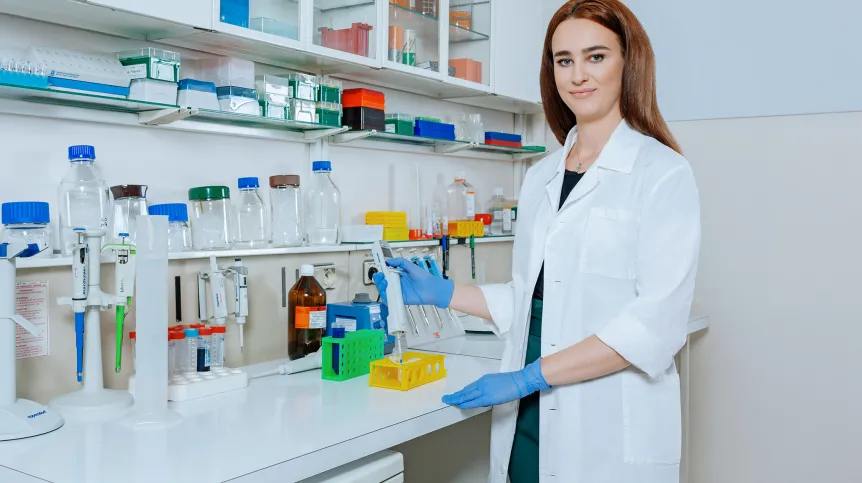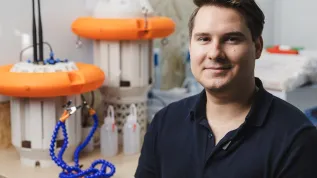
Polyglutamine diseases, such as Huntington's disease, lead to cell death in the brain. Magdalena Dąbrowska, scholarship holder in the 21st edition of the L'Oréal For Women & Science Scholarship Programme, investigates the methods for removing unwanted mutations in the genome that lead to these rare, incurable diseases.
The doctoral candidate at the Department of Genomic Engineering of the Institute of Bioorganic Chemistry PAS in Poznań is one of many scientists who explore the mechanisms of polyglutamine diseases, aiming to develop new treatment methods.
The researcher explains that these diseases are a result of a mutation consisting in an increased the number of repeats the CAG nucleotides that encode glutamine. The most common polyQ diseases include Huntington's disease and spinocerebellar ataxia. The remaining ones include dentatorubral pallidoluysian atrophy and spinal and bulbar muscular atrophy. With the exception of the latter, inherited in an X-linked recessive manner, these diseases are autosomal dominant disorders. They affect approx 1-10 in 100,000 people.
'There are nine different polyQ diseases, each of them caused by a different gene located on different chromosomes, with a different repeats threshold that cause the disease. In the case of Huntington disease, this threshold is 36 to 39 repeats. Exceeding these lengths causes the formation of a mutated protein with a lengthened CAG sequence', explains Magdalena Dąbrowska.
Symptoms of polyQ diseases are mainly related to the nervous system impairment due to the accumulation of mutated protein in neuronal cells. Their severity can only moderately reduced. 'Difficult' CAG sequence and genetic background are the challenges in developing treatment. Despite the identification and locating genes responsible for polyQ diseases, their formation mechanisms are not fully known.
Innovative method developed by Polish researcher
The doctoral candidate uses genome editing tools in experimental therapy of polyglutamine diseases. In her research, she uses 'molecular scissors', or CRISPR/Cas technology. It allows to modulate the length of the CAG repeat sequence in cells from patients suffering from polyQ diseases.
Molecular scissors allow to make a cut at a specific location in the genome. This method is used to create new cellular and animal models, and in genetic diseases therapy.
Magdalena Dąbrowska uses this technology to break DNA threads in the area of CAG repeat sequence. The L'Oréal-UNESCO scholarship holder was the first to created a potential therapeutic approach for polyQ diseases. It consists in using a modified version of nuclease CAS9 called CAS9 nickase to cut the mutated CAG sequence in cells from patients with Huntington's disease.
This approach turned out to be effective, and most importantly did not cause side effects. The research results resulted in questions about the mechanisms that take part in the repair of DNA thread cracks in the area of CAG repeat sequences and how to effectively detect mutations in this 'difficult' area of the genome. Dąbrowska answered the later question by creating a new genetic engineering method called qEva-CRISPR.
qEva-CRISPR allows to detect mutations caused by CRISPR-Cas9 in different genome areas, also in repeating sequences.
'It is easy to use, it has a protocol tailored to any type of cells and most importantly, it allows to simultaneously detect changes in the target sequence and the sequences outside the planned cutting place. It facilitates routine laboratory work with CRISPR-Cas9 technology and allows to more accurately study the still not fully known edition effects', says Magdalena Dąbrowska.
A new therapeutic strategy?
The scientists currently conducts research on DNA repair mechanisms that are responsible for shortening or extending the repeated sequence after induction of DNA thread cracks in this area. Knowledge obtained during her research will allow to control these mechanisms. This, in turn, can lead to preferential shortening of the CAG sequence. The innovative approach can become the basis for creating a new therapeutic strategy.
For his scientific achievements, Magdalena Dąbrowska received the Wacław Szybalski Prize granted by the Biotechnology Committee PAS for the best experimental work conducted in a Polish laboratory, and the Poznań Branch of the Polish Academy of Sciences Award for the best original creative work in biological and agricultural sciences. In 2021, she received a scholarship for the 21st edition of the L'Oréal For Women & Science Scholarship Programme in the doctoral candidate category for the research project 'The use of genetic tools in experimental therapy for polyglutamine diseases'. Magdalena Dąbrowska's achievements were also recognised by Forbes Women as one of the 100 Forbes Women 2021. The annual list includes political leaders, activists, businesswomen, scientist, artists and innovators.
Magdalena Dąbrowska is a medical analytics (laboratory medicine) graduate from the Medical University of Bialystok. During her studies, she was an intern at the University Clinical Hospital in Bialystok, and after graduation in the Medical Genetics Laboratory at the Children's Memorial Health Institute in Warsaw. She worked as junior assistant in the Central Clinical Laboratory at the National Geriatrics, Rheumatology and Rehabilitation Institute in Warsaw. In 2016, she started doctoral studies. She published 6 scientific papers, of which 4 are experimental works. She is a laureate of Preludium 20 and Etiuda 8 grants awarded by the National Science Centre. As part of the last grant, she completed a 6-month fellowship at the Swiss Federal Institute of Technology in Zürich.
PAP - Science in Poland
kol/ agt/ kap/
tr. RL













